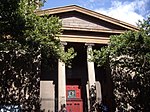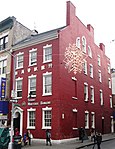Chatham Square
Chinatown, ManhattanSquares in ManhattanStreets in ManhattanUse mdy dates from July 2021

Chatham Square is a major intersection in Chinatown, Manhattan, New York City. The square lies at the confluence of eight streets: the Bowery, Doyers Street, East Broadway, St. James Place, Mott Street, Oliver Street, Worth Street and Park Row. The small park in the center of the square is known as Kimlau Square and Lin Ze Xu Square.
Excerpt from the Wikipedia article Chatham Square (License: CC BY-SA 3.0, Authors, Images).Chatham Square
Chatham Square, New York Manhattan
Geographical coordinates (GPS) Address Nearby Places Show on map
Geographical coordinates (GPS)
| Latitude | Longitude |
|---|---|
| N 40.713611111111 ° | E -73.998055555556 ° |
Address
Chatham Square 22
10038 New York, Manhattan
New York, United States
Open on Google Maps






